In January 2014, Kline & Company, a worldwide consulting and research firm serving needs of organizations in the lubricants and base stocks industry, introduced its monthly Base Stock Margin Index, a characterization of recent cash margin contributions in the U.S. base oil market over the past 24 months.
The Index estimates cash margin contributions associated with U.S. Group II base stock production. It simulates EBITDA before the deduction of corporate SG&A expenses for typical VGO-based virgin base stock plants and RFO-based re-refineries.
“Since the last release of the Margin Index, Brent crude oil prices have increased by one-third,” noted Ian Moncrieff, Vice President of Kline’s Energy Practice. “Brent crude oil increased from an average of $33.70/Bbl in quarter one, to $45.52/Bbl in quarter two, and then held steady through the first two months of quarter three. While VGO feedstock price increases for conventional Group II refiners were similar to those for Brent (i.e., VGO cracks remained stable), re-refiners experienced a smaller increase in UMO feed prices from quarter one to quarter two, as used oil collector/aggregators were able to limit reductions in pay-for-oil fees required of used oil generators as heavy fuel oil prices increased.”
“On the revenue side, base oil contract prices eventually climbed in response to VGO price increases, though lagging the fuels market by almost two months. Additionally, conventional refiners had the benefit of stronger diesel prices in June allowing them to show a higher growth in base oil cash margin profitability. Partially offsetting the oil-driven margin uplift in conventional Group II production was the increased cost of fuel, with Henry Hub spot natural gas prices increasing from a low of $1.73/MMBtu in March to $2.82 in July.”
“On the demand side, the U.S. Energy Information Administration continues to report increases in ‘Product Supplied of Lubricants,’ which we believe is a close simulation of U.S. internal demand for base oils, where reported base oil production less net exports and inventory change is equated to consumption (domestic disappearance). Reported U.S. ‘lubricant’ product supplied increased by almost 7% from 2014 to 2015, and the first half of 2016 is up 1% on 1H, 2015.”
Moncrieff added, “Kline, in association with SBA consulting, has introduced the Base Oil Plant Health Check earlier this year. This service will combine the industry-leading market, commercial and technical insights of Kline’s Energy practice working in close association with Steve Ames. With the underlying weakness to supply/demand and capacity utilization fundamentals, an analysis into the past and likely future profitability of a base oil plant(s), can help the refiner evaluate opportunities for enhancing its competitiveness against its industry peers.”
For more information on the Health Check study, the Kline Index, or to inquire about our pricing and margin analysis services to the base stocks industry, please contact Ian Moncrieff, Vice President (Ian.Moncrieff@klinegroup.com) at (973)-615-3680 in Kline’s Energy Practice.

